
llama-zip
LLM-powered lossless compression tool
Stars: 158
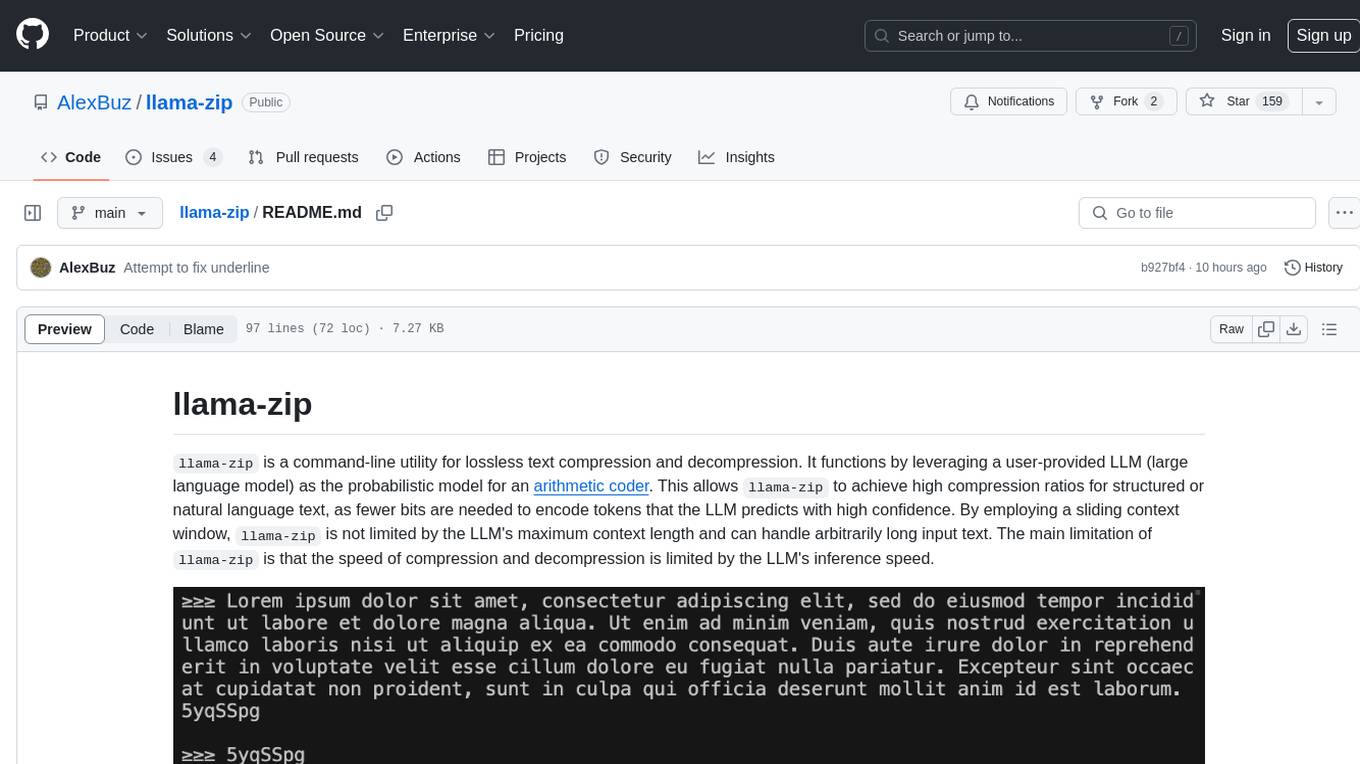
llama-zip is a command-line utility for lossless text compression and decompression. It leverages a user-provided large language model (LLM) as the probabilistic model for an arithmetic coder, achieving high compression ratios for structured or natural language text. The tool is not limited by the LLM's maximum context length and can handle arbitrarily long input text. However, the speed of compression and decompression is limited by the LLM's inference speed.
README:
llama-zip is a command-line utility for lossless text compression and decompression. It functions by leveraging a user-provided LLM (large language model) as the probabilistic model for an arithmetic coder. This allows llama-zip to achieve high compression ratios for structured or natural language text, as fewer bits are needed to encode tokens that the LLM predicts with high confidence. By employing a sliding context window, llama-zip is not limited by the LLM's maximum context length and can handle arbitrarily long input text. The main limitation of llama-zip is that the speed of compression and decompression is limited by the LLM's inference speed.
In the table below, the compression ratios achieved by llama-zip on the text files of the Calgary Corpus (as well as on llama-zip's own source code) are compared to other popular or high-performance compression utilities. Compression ratios are calculated by dividing the number of bytes in the input by the number of bytes in the output, so higher values indicate better compression. For llama-zip, the LLM used was Llama 3 8B (Q4_K_M) with a window overlap of 25%. For the other utilities, the maximum compression level was used.
| File | llama-zip | bzip2 | paq8pxd | xz | zpaq | zstd |
|---|---|---|---|---|---|---|
| bib | 8.523 | 4.051 | 5.590 | 3.636 | 4.611 | 3.485 |
| book1 | 6.943 | 3.305 | 4.204 | 2.941 | 3.823 | 2.904 |
| book2 | 8.127 | 3.880 | 5.325 | 3.596 | 4.649 | 3.514 |
| news | 5.590 | 3.180 | 4.494 | 3.171 | 3.817 | 3.073 |
| paper1 | 7.637 | 3.211 | 4.212 | 3.074 | 3.572 | 3.017 |
| paper2 | 8.375 | 3.283 | 4.135 | 3.015 | 3.679 | 2.982 |
| progc | 4.425 | 3.158 | 4.352 | 3.151 | 3.495 | 3.096 |
| progl | 5.194 | 4.599 | 7.347 | 4.787 | 5.554 | 4.728 |
| progp | 6.309 | 4.611 | 7.508 | 4.772 | 5.348 | 4.724 |
| trans | 9.810 | 5.235 | 8.409 | 5.613 | 6.597 | 5.417 |
| llama_zip.py | 5.859 | 3.508 | 4.689 | 3.552 | 3.018 | 3.633 |
The best-performing compressor for each file is listed in bold, and the second-best is underlined.
git clone https://github.com/alexbuz/llama-zip.git
cd llama-zip
pip3 install .To use llama-zip, you must first download an LLM that is compatible with llama.cpp, such as Llama 3 8B. Make sure to download a quantized version (one of the .gguf files listed on the "Files and versions" tab on Hugging Face) that is small enough to fit in your system's memory.
llama-zip <llm_path> [options] <mode> [input]
llama-zip supports three modes of operation:
-
Compress mode (specified by the
-cor--compressflag): The string to be compressed can be provided as an argument or piped to stdin. The compressed output will be encoded in base64 and printed to stdout. -
Decompress mode (specified by the
-dor--decompressflag): The compressed string can be provided as an argument or piped to stdin. The decompressed output will be printed to stdout. -
Interactive mode (specified by the
-ior--interactiveflag): A prompt is displayed where the user can enter strings to be compressed or decompressed. When a base64-encoded string is entered, it will be decompressed; otherwise, the entered string will be compressed. After each compression or decompression operation, the user is prompted to enter another string. To exit interactive mode, pressCtrl+C.-
Note: If you would like to compress a string that consists entirely of base64 characters (i.e., letters, numbers,
+, and/, without any other symbols or spaces), you must use compression mode directly, as interactive mode assumes that base64-encoded strings are meant to be decompressed and will result in nonsensical output if the input did not come from a compression operation. Alternatively, you can add a non-base64 character to your string (such as a space at the end) if you don't mind your string being compressed with that extra character.
-
Note: If you would like to compress a string that consists entirely of base64 characters (i.e., letters, numbers,
-
-w,--window-overlap: The number of tokens to overlap between the end of the previous context window and the start of the next window, when compressing a string whose length exceeds the LLM's maximum context length. This can be specified as a percentage of the LLM's context length or as a fixed number of tokens. The default is0%, meaning that the context window is cleared entirely when it is filled. Higher values can improve compression ratios but will slow down compression and decompression, since parts of the text will need to be re-evaluated when the context window slides. Note that when decompressing, the window overlap must be set to the same value that was used during compression in order to recover the original text. -
--n_gpu_layers: The--n_gpu_layersargument in the code specifies the number of layers in the model that should be offloaded to the GPU for computation. This can significantly speed up the processing time, especially for larger models, as the GPU is typically much faster at performing matrix operations than a CPU. If--n_gpu_layersis set to -1 or None, all layers of the model will be offloaded to the GPU. Check llama.cpp's readme for better understanding of this parameter.
-
Compressing a string:
llama-zip /path/to/Meta-Llama-3-8B.Q8_0.gguf -c "The quick brown fox jumps over the lazy dog." # Output: SxapgbY
-
Compressing text from a file:
llama-zip /path/to/Meta-Llama-3-8B.Q8_0.gguf -c < /path/to/gettysburg_address.txt # Output: 4vTMmKKTXWAcNZwPwkqN84
-
Compressing text from a file and saving the output to another file:
llama-zip /path/to/Meta-Llama-3-8B.Q8_0.gguf -c < /path/to/input.txt > /path/to/output.compressed
-
Decompressing a compressed string:
llama-zip /path/to/Meta-Llama-3-8B.Q8_0.gguf -d SxapgbY # Output: The quick brown fox jumps over the lazy dog. -
Decompressing text from a file:
llama-zip /path/to/Meta-Llama-3-8B.Q8_0.gguf -d < /path/to/input.compressed # Output: [decompressed text]
-
Decompressing text from a file and saving the output to another file:
llama-zip /path/to/Meta-Llama-3-8B.Q8_0.gguf -d < /path/to/input.compressed > /path/to/output.txt
For Tasks:
Click tags to check more tools for each tasksFor Jobs:
Alternative AI tools for llama-zip
Similar Open Source Tools

llama-zip
llama-zip is a command-line utility for lossless text compression and decompression. It leverages a user-provided large language model (LLM) as the probabilistic model for an arithmetic coder, achieving high compression ratios for structured or natural language text. The tool is not limited by the LLM's maximum context length and can handle arbitrarily long input text. However, the speed of compression and decompression is limited by the LLM's inference speed.
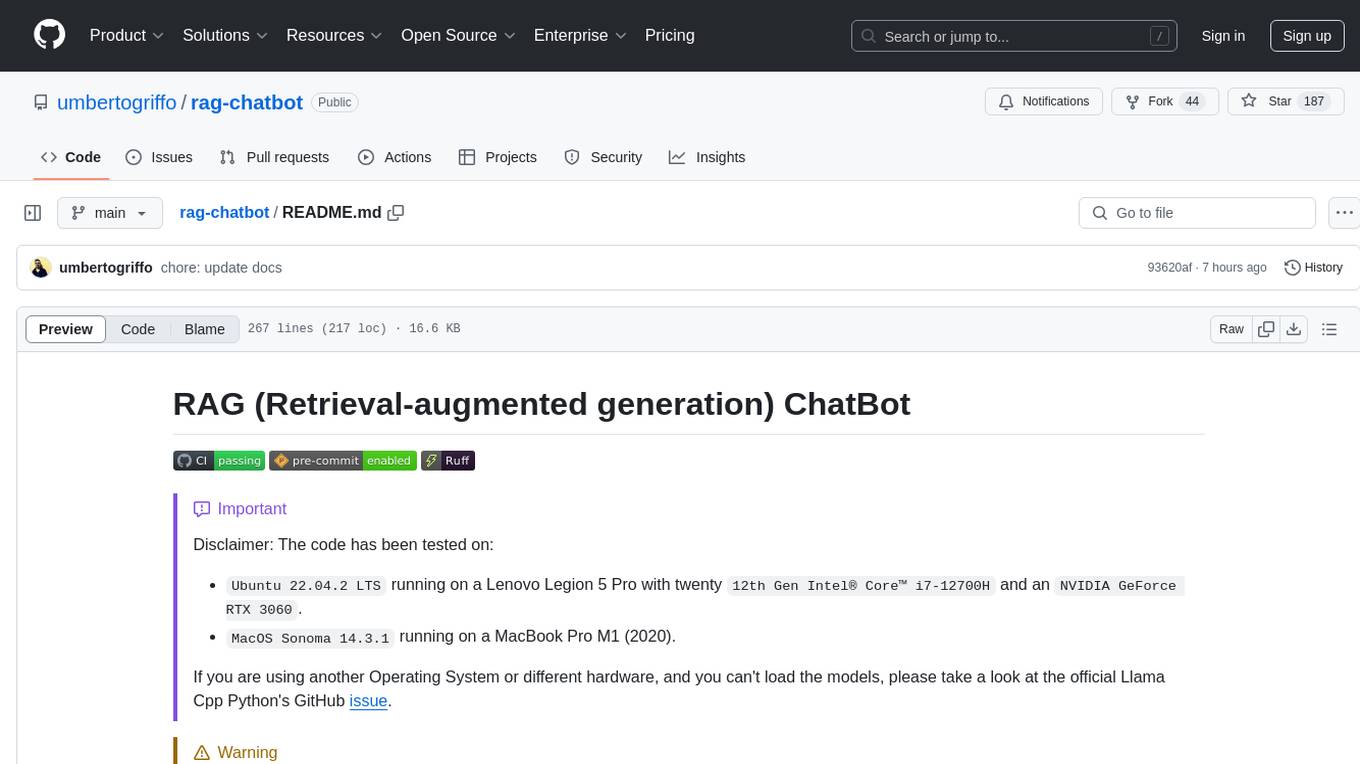
rag-chatbot
The RAG ChatBot project combines Lama.cpp, Chroma, and Streamlit to build a Conversation-aware Chatbot and a Retrieval-augmented generation (RAG) ChatBot. The RAG Chatbot works by taking a collection of Markdown files as input and provides answers based on the context provided by those files. It utilizes a Memory Builder component to load Markdown pages, divide them into sections, calculate embeddings, and save them in an embedding database. The chatbot retrieves relevant sections from the database, rewrites questions for optimal retrieval, and generates answers using a local language model. It also remembers previous interactions for more accurate responses. Various strategies are implemented to deal with context overflows, including creating and refining context, hierarchical summarization, and async hierarchical summarization.
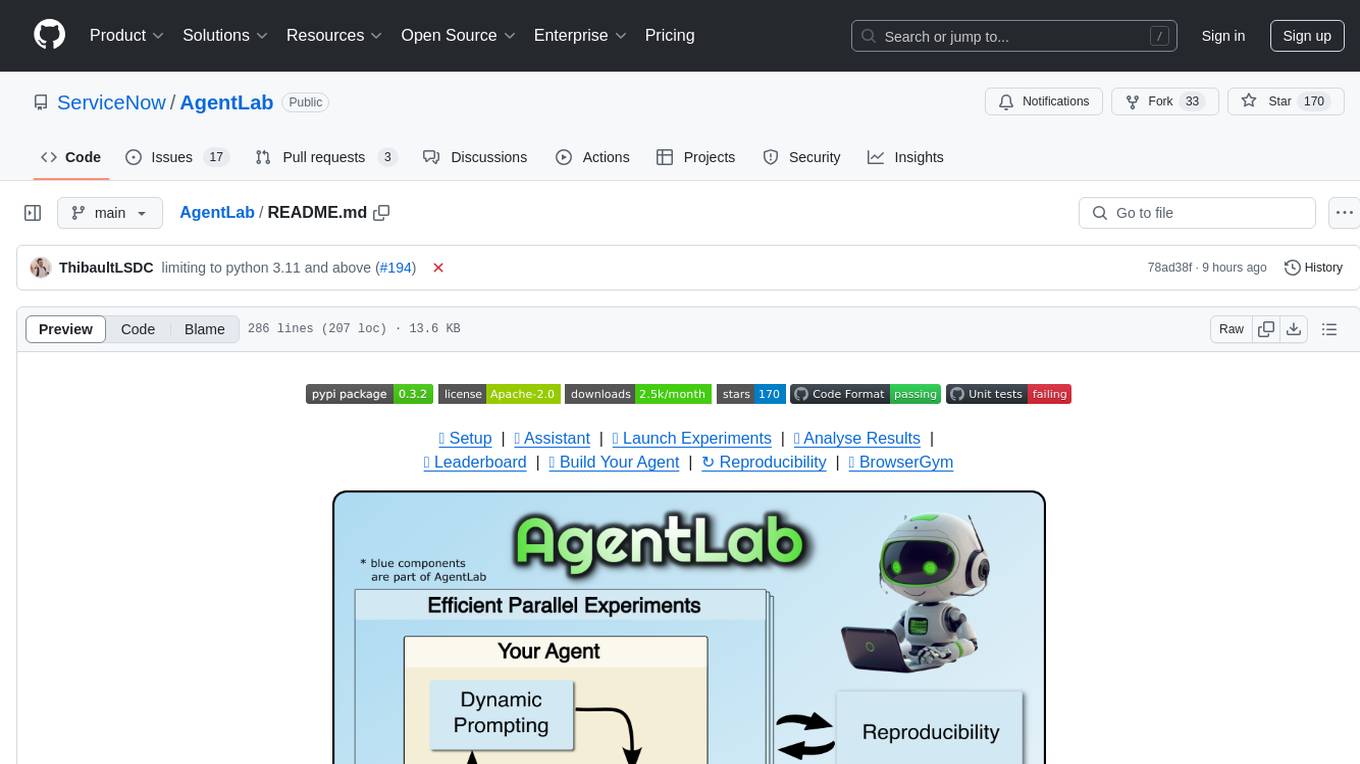
AgentLab
AgentLab is an open, easy-to-use, and extensible framework designed to accelerate web agent research. It provides features for developing and evaluating agents on various benchmarks supported by BrowserGym. The framework allows for large-scale parallel agent experiments using ray, building blocks for creating agents over BrowserGym, and a unified LLM API for OpenRouter, OpenAI, Azure, or self-hosted using TGI. AgentLab also offers reproducibility features, a unified LeaderBoard, and supports multiple benchmarks like WebArena, WorkArena, WebLinx, VisualWebArena, AssistantBench, GAIA, Mind2Web-live, and MiniWoB.
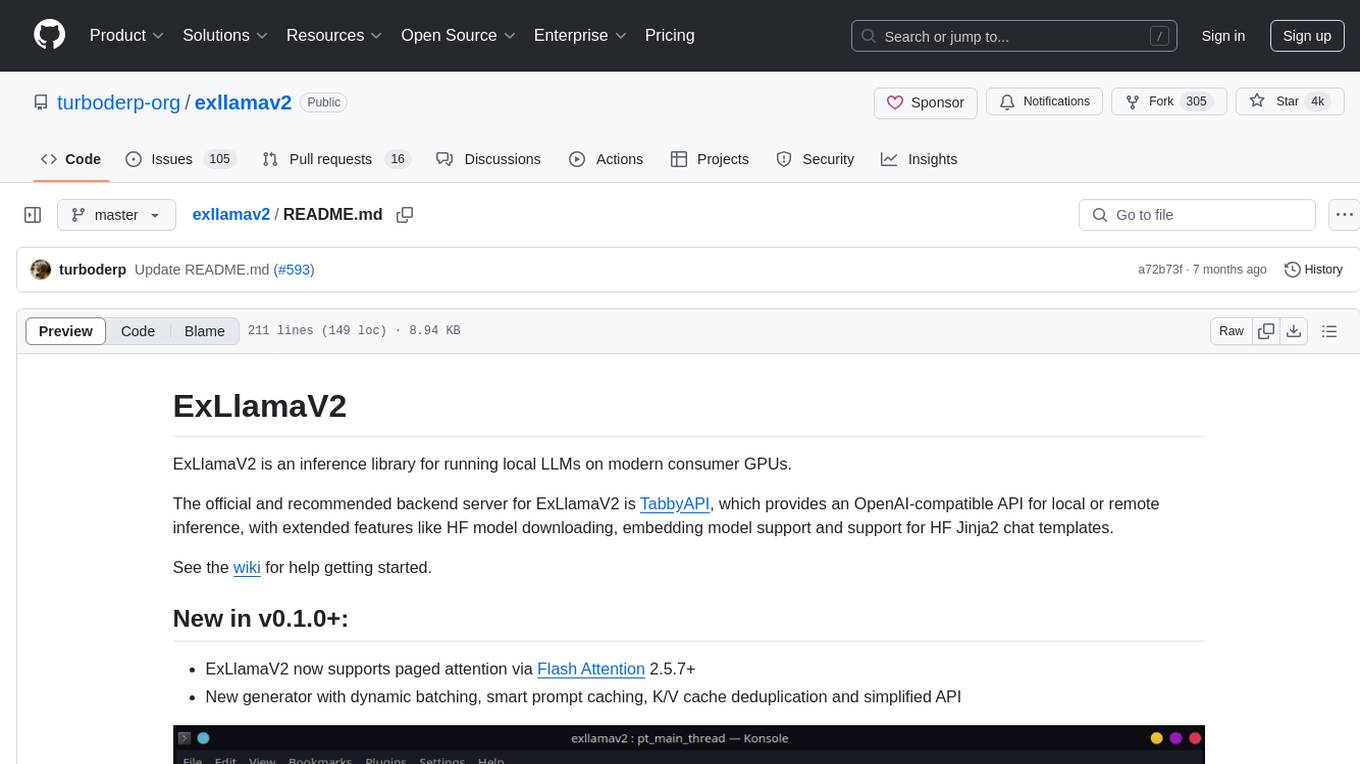
exllamav2
ExLlamaV2 is an inference library designed for running local LLMs on modern consumer GPUs. The library supports paged attention via Flash Attention 2.5.7+, offers a new dynamic generator with features like dynamic batching, smart prompt caching, and K/V cache deduplication. It also provides an API for local or remote inference using TabbyAPI, with extended features like HF model downloading and support for HF Jinja2 chat templates. ExLlamaV2 aims to optimize performance and speed across different GPU models, with potential future optimizations and variations in speeds. The tool can be integrated with TabbyAPI for OpenAI-style web API compatibility and supports a standalone web UI called ExUI for single-user interaction with chat and notebook modes. ExLlamaV2 also offers support for text-generation-webui and lollms-webui through specific loaders and bindings.
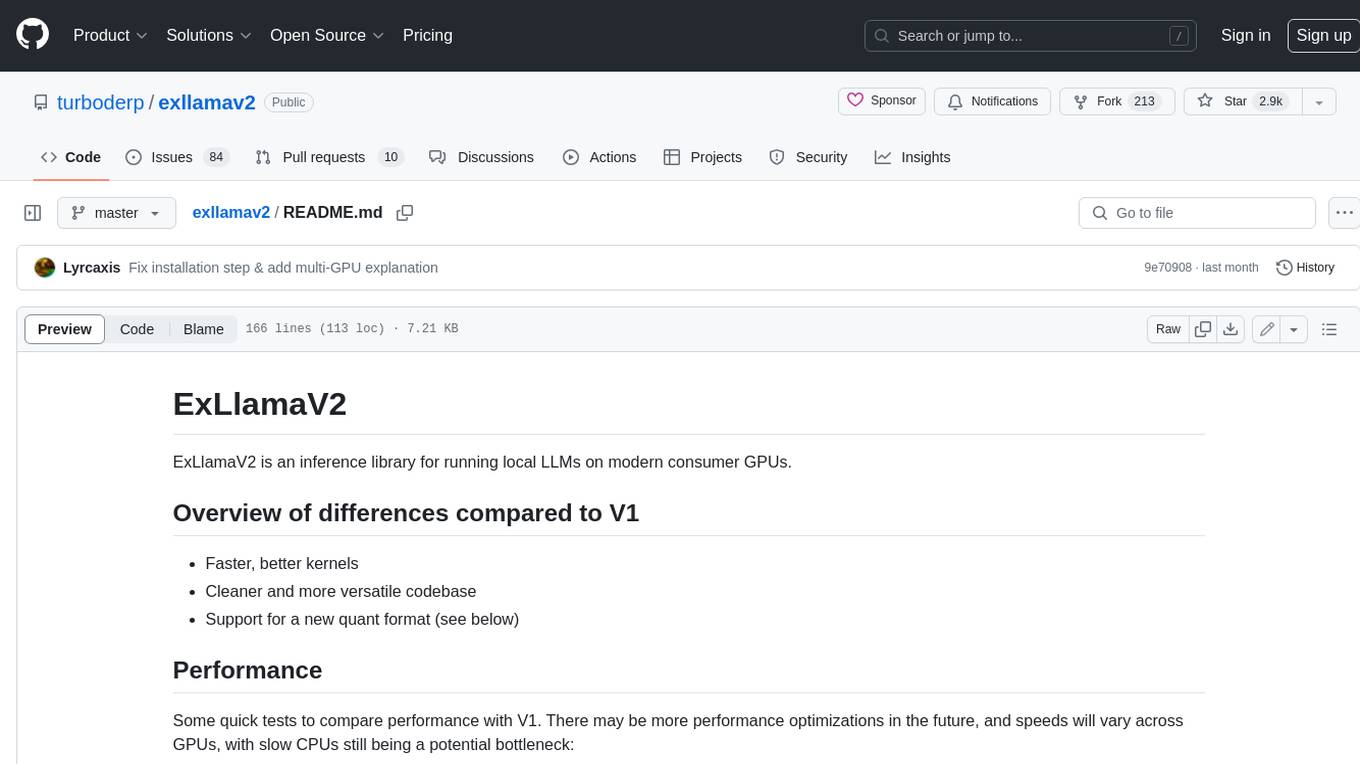
exllamav2
ExLlamaV2 is an inference library for running local LLMs on modern consumer GPUs. It is a faster, better, and more versatile codebase than its predecessor, ExLlamaV1, with support for a new quant format called EXL2. EXL2 is based on the same optimization method as GPTQ and supports 2, 3, 4, 5, 6, and 8-bit quantization. It allows for mixing quantization levels within a model to achieve any average bitrate between 2 and 8 bits per weight. ExLlamaV2 can be installed from source, from a release with prebuilt extension, or from PyPI. It supports integration with TabbyAPI, ExUI, text-generation-webui, and lollms-webui. Key features of ExLlamaV2 include: - Faster and better kernels - Cleaner and more versatile codebase - Support for EXL2 quantization format - Integration with various web UIs and APIs - Community support on Discord
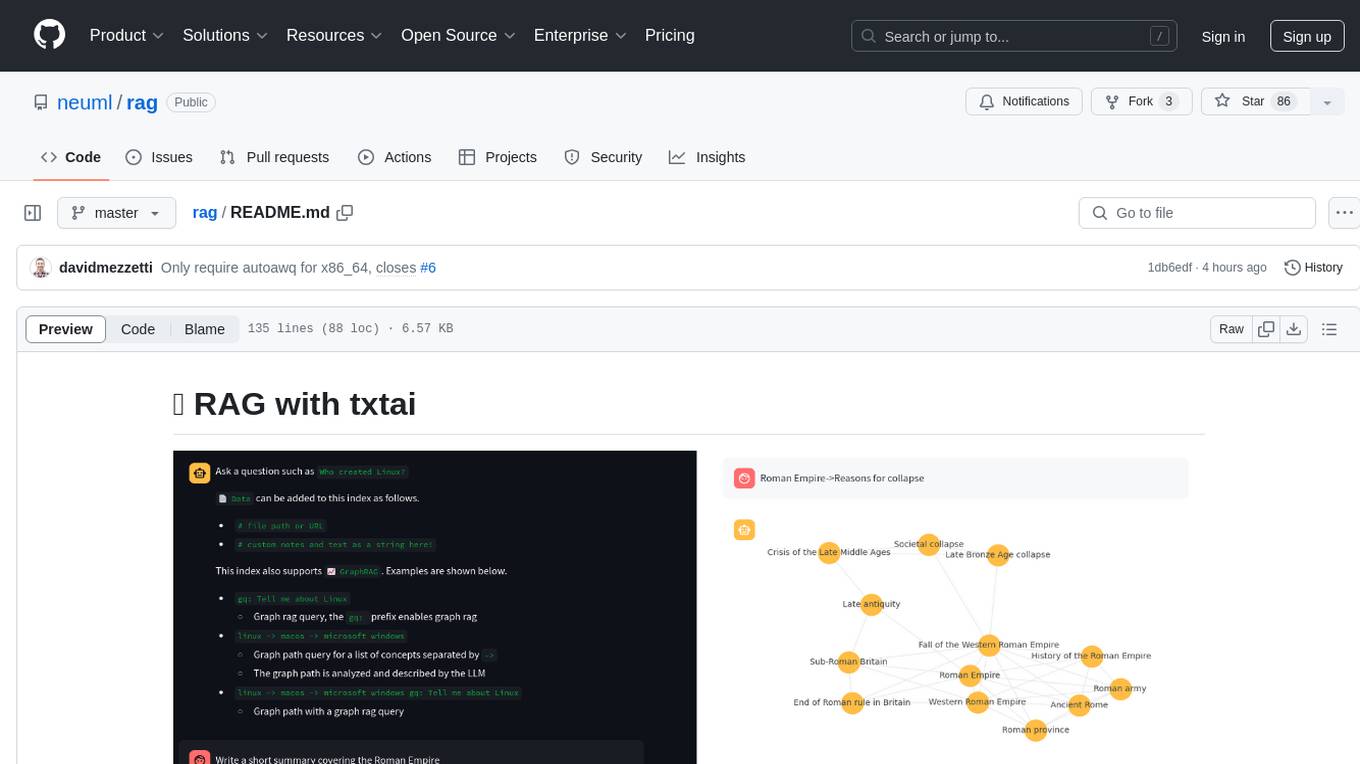
rag
RAG with txtai is a Retrieval Augmented Generation (RAG) Streamlit application that helps generate factually correct content by limiting the context in which a Large Language Model (LLM) can generate answers. It supports two categories of RAG: Vector RAG, where context is supplied via a vector search query, and Graph RAG, where context is supplied via a graph path traversal query. The application allows users to run queries, add data to the index, and configure various parameters to control its behavior.
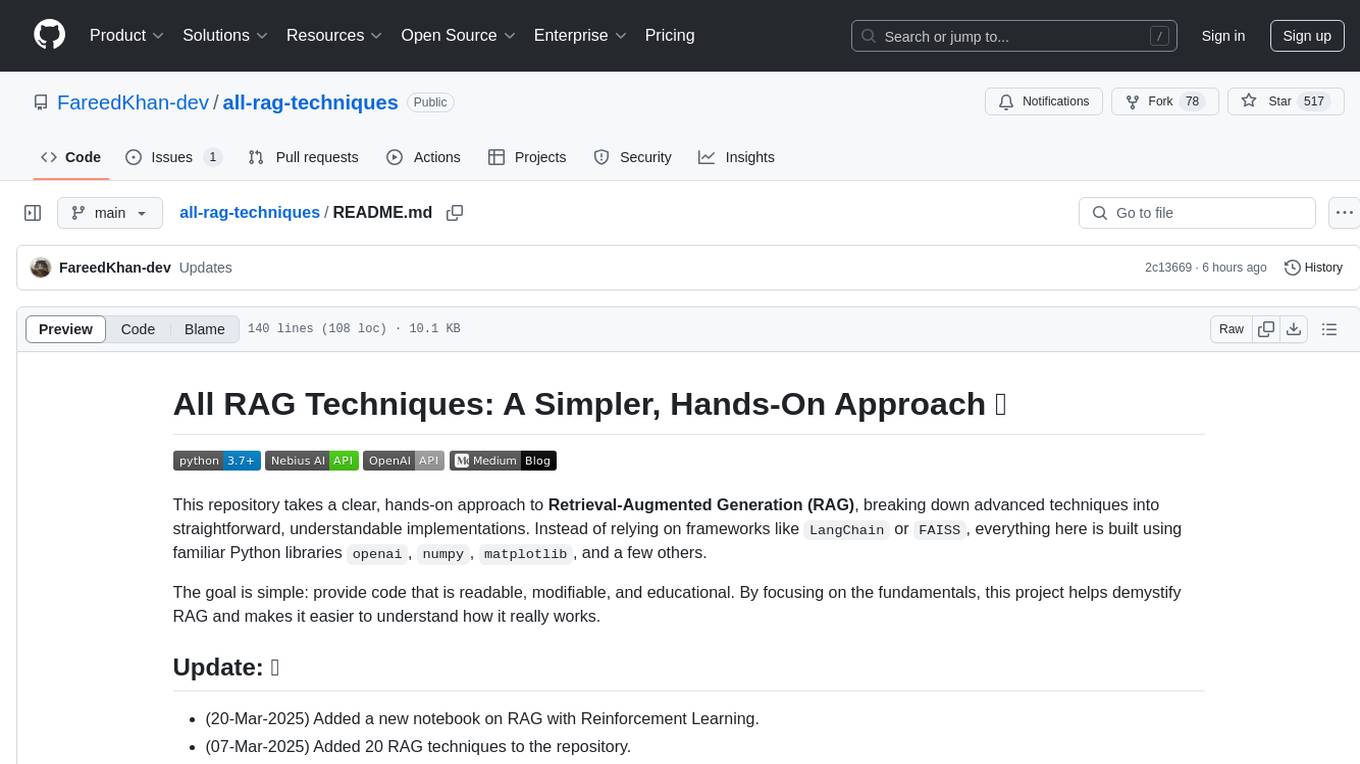
all-rag-techniques
This repository provides a hands-on approach to Retrieval-Augmented Generation (RAG) techniques, simplifying advanced concepts into understandable implementations using Python libraries like openai, numpy, and matplotlib. It offers a collection of Jupyter Notebooks with concise explanations, step-by-step implementations, code examples, evaluations, and visualizations for various RAG techniques. The goal is to make RAG more accessible and demystify its workings for educational purposes.
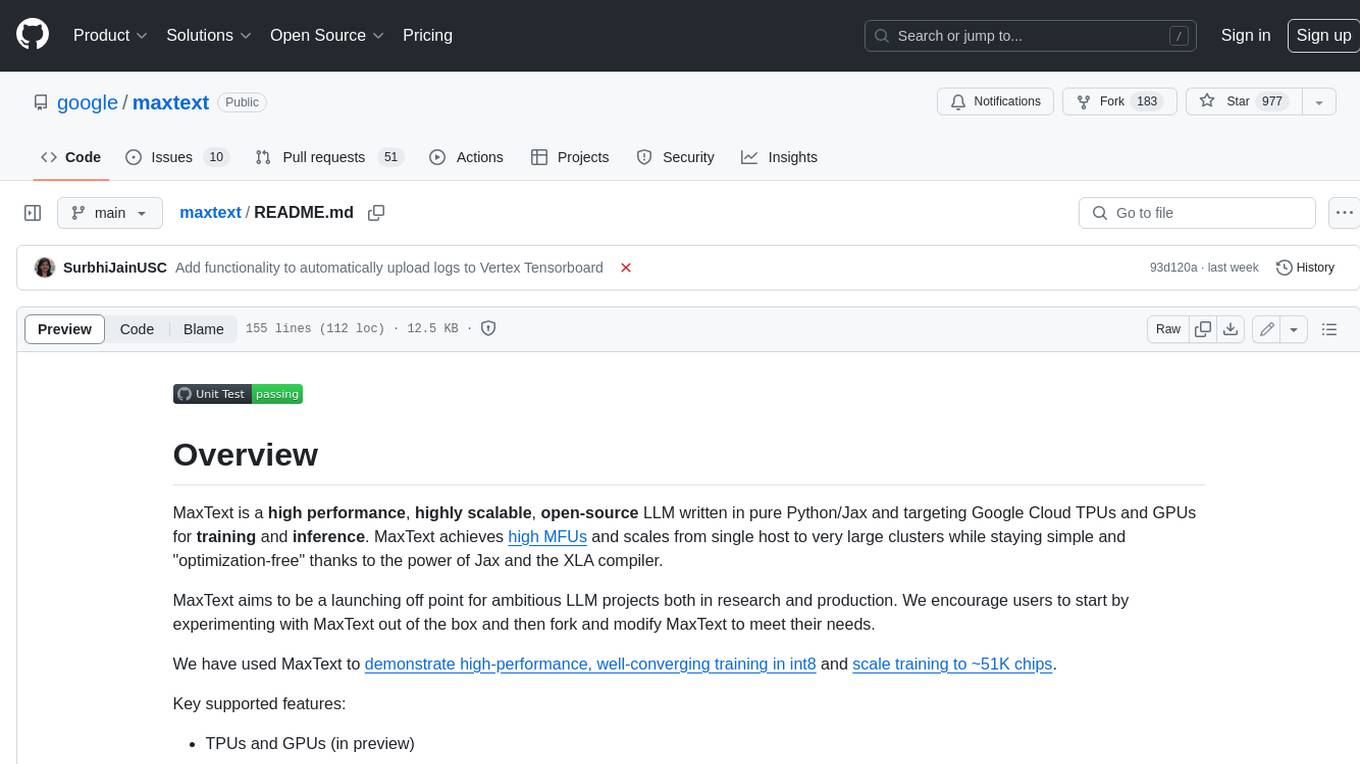
maxtext
MaxText is a high-performance, highly scalable, open-source LLM written in pure Python/Jax and targeting Google Cloud TPUs and GPUs for training and inference. MaxText achieves high MFUs and scales from single host to very large clusters while staying simple and "optimization-free" thanks to the power of Jax and the XLA compiler. MaxText aims to be a launching off point for ambitious LLM projects both in research and production. We encourage users to start by experimenting with MaxText out of the box and then fork and modify MaxText to meet their needs.
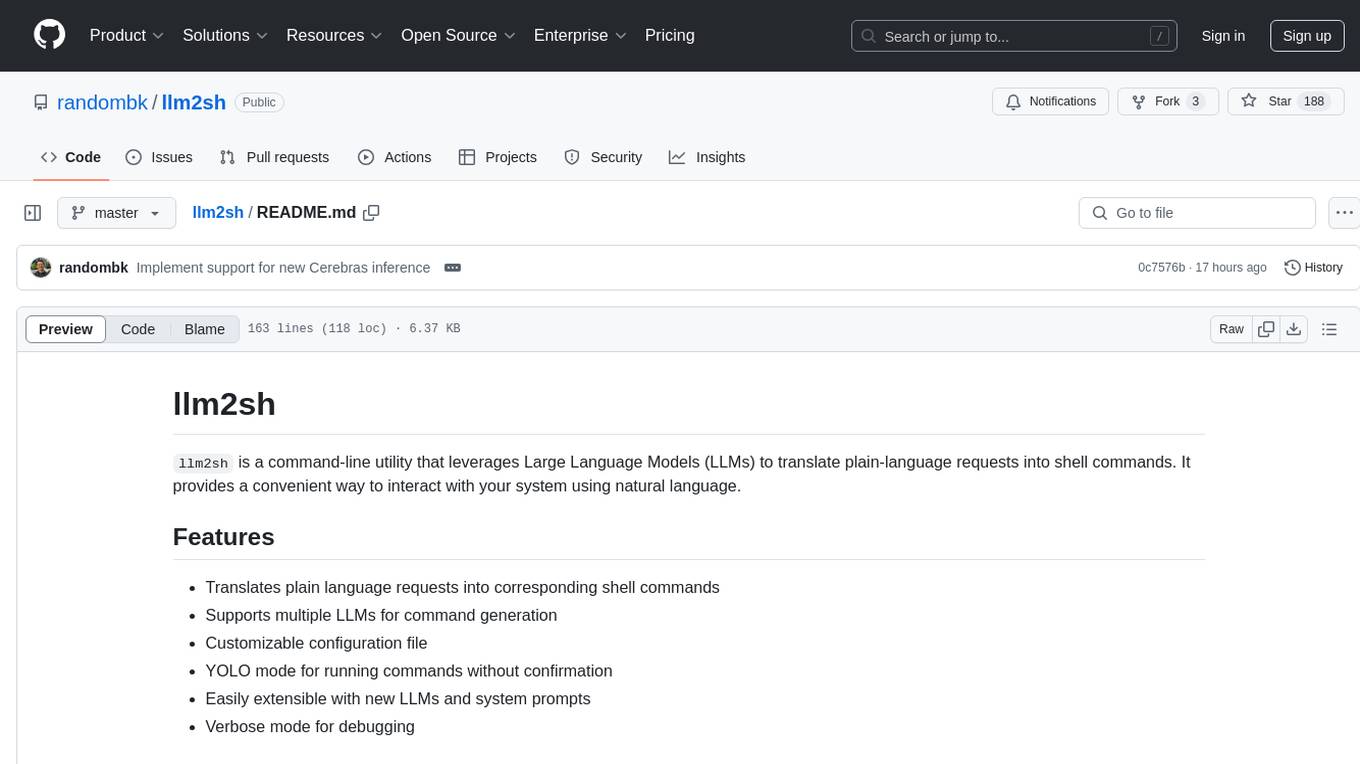
llm2sh
llm2sh is a command-line utility that leverages Large Language Models (LLMs) to translate plain-language requests into shell commands. It provides a convenient way to interact with your system using natural language. The tool supports multiple LLMs for command generation, offers a customizable configuration file, YOLO mode for running commands without confirmation, and is easily extensible with new LLMs and system prompts. Users can set up API keys for OpenAI, Claude, Groq, and Cerebras to use the tool effectively. llm2sh does not store user data or command history, and it does not record or send telemetry by itself, but the LLM APIs may collect and store requests and responses for their purposes.
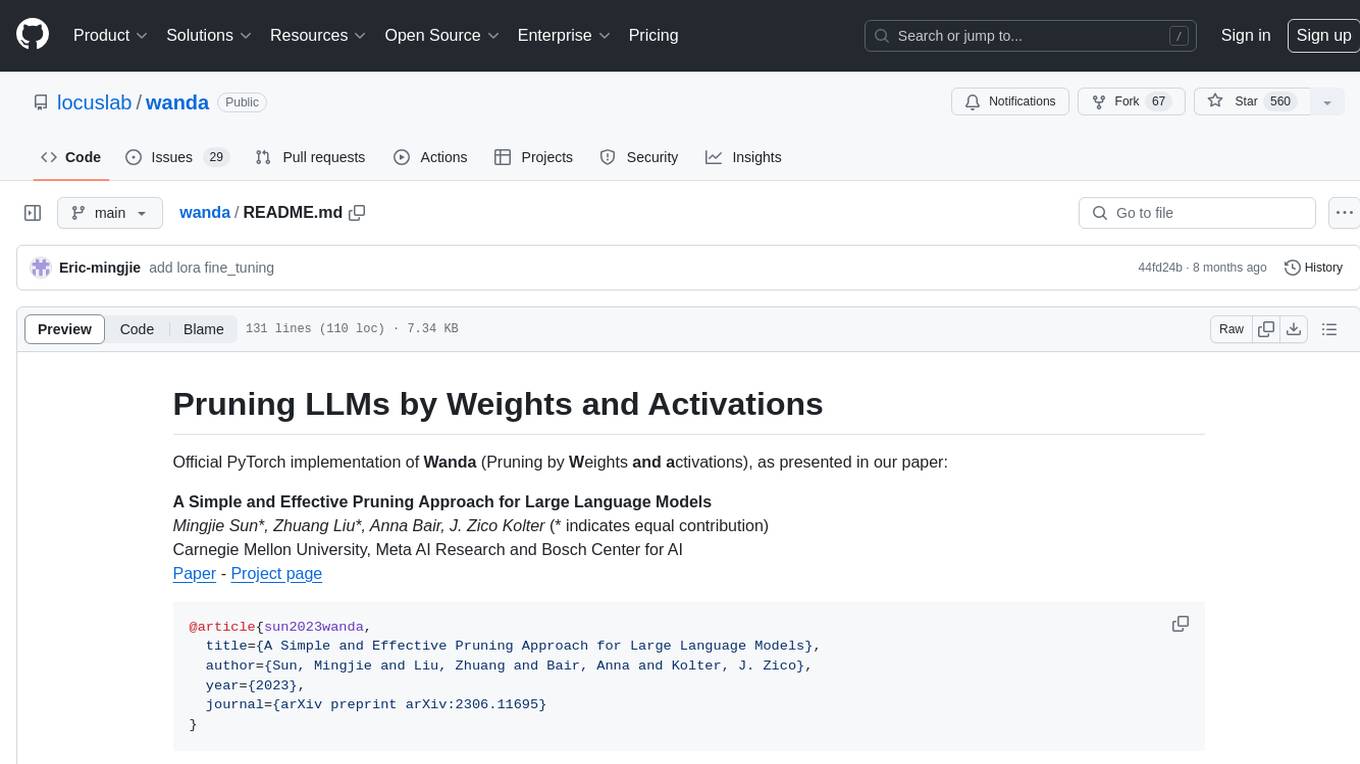
wanda
Official PyTorch implementation of Wanda (Pruning by Weights and Activations), a simple and effective pruning approach for large language models. The pruning approach removes weights on a per-output basis, by the product of weight magnitudes and input activation norms. The repository provides support for various features such as LLaMA-2, ablation study on OBS weight update, zero-shot evaluation, and speedup evaluation. Users can replicate main results from the paper using provided bash commands. The tool aims to enhance the efficiency and performance of language models through structured and unstructured sparsity techniques.
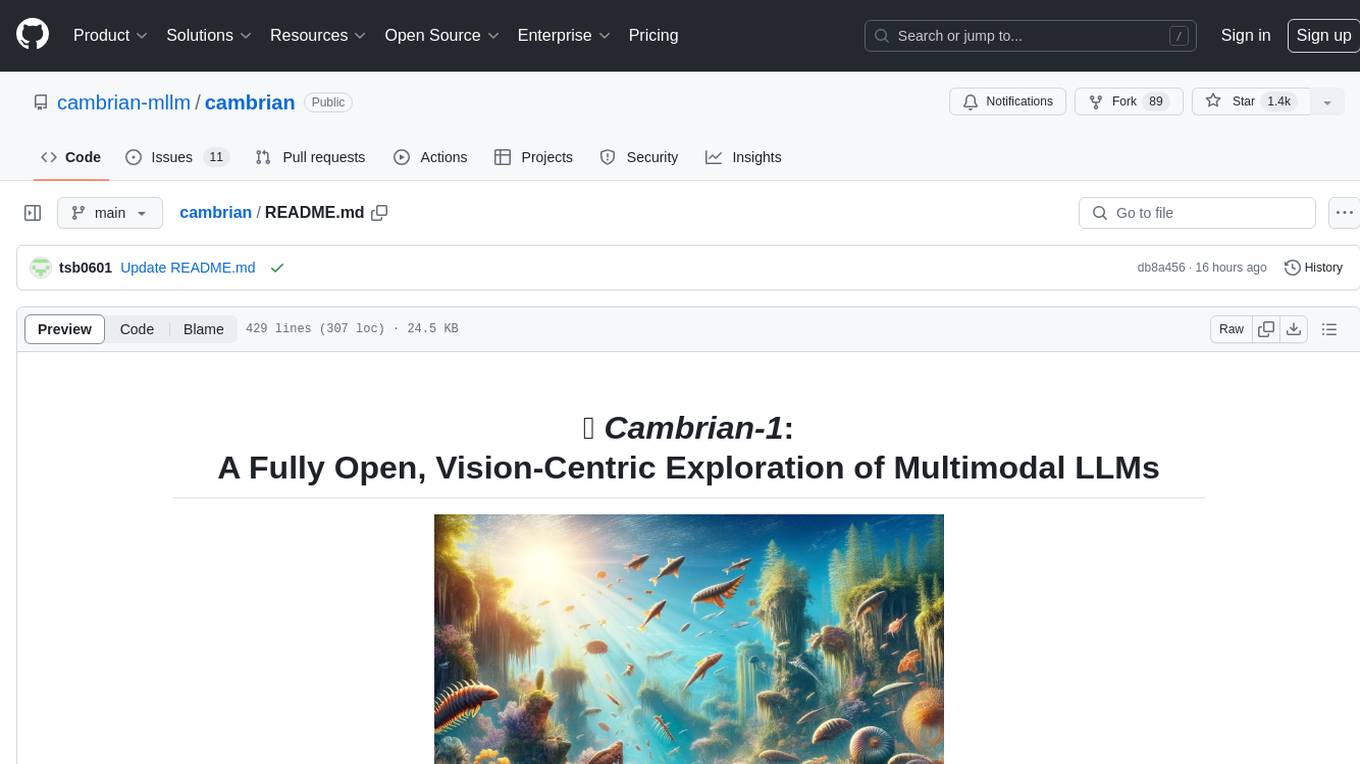
cambrian
Cambrian-1 is a fully open project focused on exploring multimodal Large Language Models (LLMs) with a vision-centric approach. It offers competitive performance across various benchmarks with models at different parameter levels. The project includes training configurations, model weights, instruction tuning data, and evaluation details. Users can interact with Cambrian-1 through a Gradio web interface for inference. The project is inspired by LLaVA and incorporates contributions from Vicuna, LLaMA, and Yi. Cambrian-1 is licensed under Apache 2.0 and utilizes datasets and checkpoints subject to their respective original licenses.
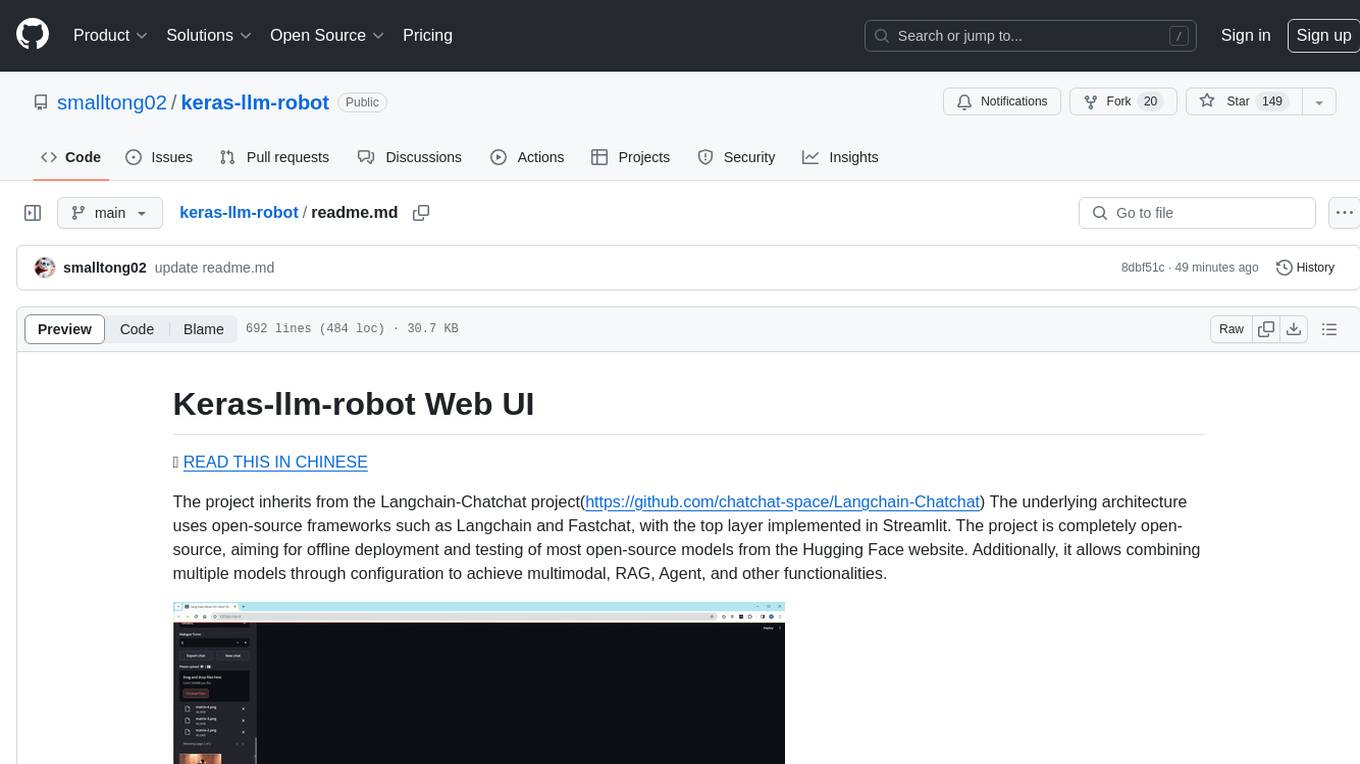
keras-llm-robot
The Keras-llm-robot Web UI project is an open-source tool designed for offline deployment and testing of various open-source models from the Hugging Face website. It allows users to combine multiple models through configuration to achieve functionalities like multimodal, RAG, Agent, and more. The project consists of three main interfaces: chat interface for language models, configuration interface for loading models, and tools & agent interface for auxiliary models. Users can interact with the language model through text, voice, and image inputs, and the tool supports features like model loading, quantization, fine-tuning, role-playing, code interpretation, speech recognition, image recognition, network search engine, and function calling.
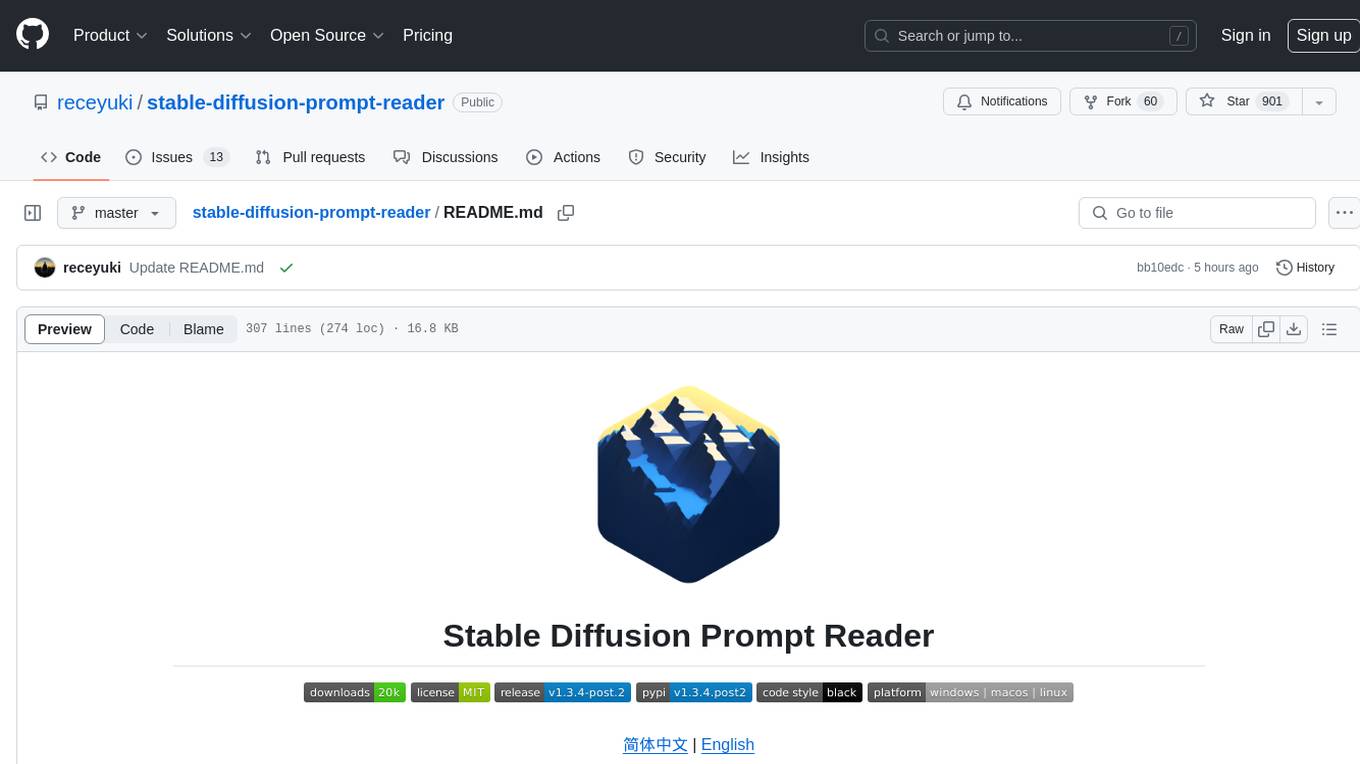
stable-diffusion-prompt-reader
A simple standalone viewer for reading prompt from Stable Diffusion generated image outside the webui. The tool supports macOS, Windows, and Linux, providing both GUI and CLI functionalities. Users can interact with the tool through drag and drop, copy prompt to clipboard, remove prompt from image, export prompt to text file, edit or import prompt to images, and more. It supports multiple formats including PNG, JPEG, WEBP, TXT, and various tools like A1111's webUI, Easy Diffusion, StableSwarmUI, Fooocus-MRE, NovelAI, InvokeAI, ComfyUI, Draw Things, and Naifu(4chan). Users can download the tool for different platforms and install it via Homebrew Cask or pip. The tool can be used to read, export, remove, and edit prompts from images, providing various modes and options for different tasks.
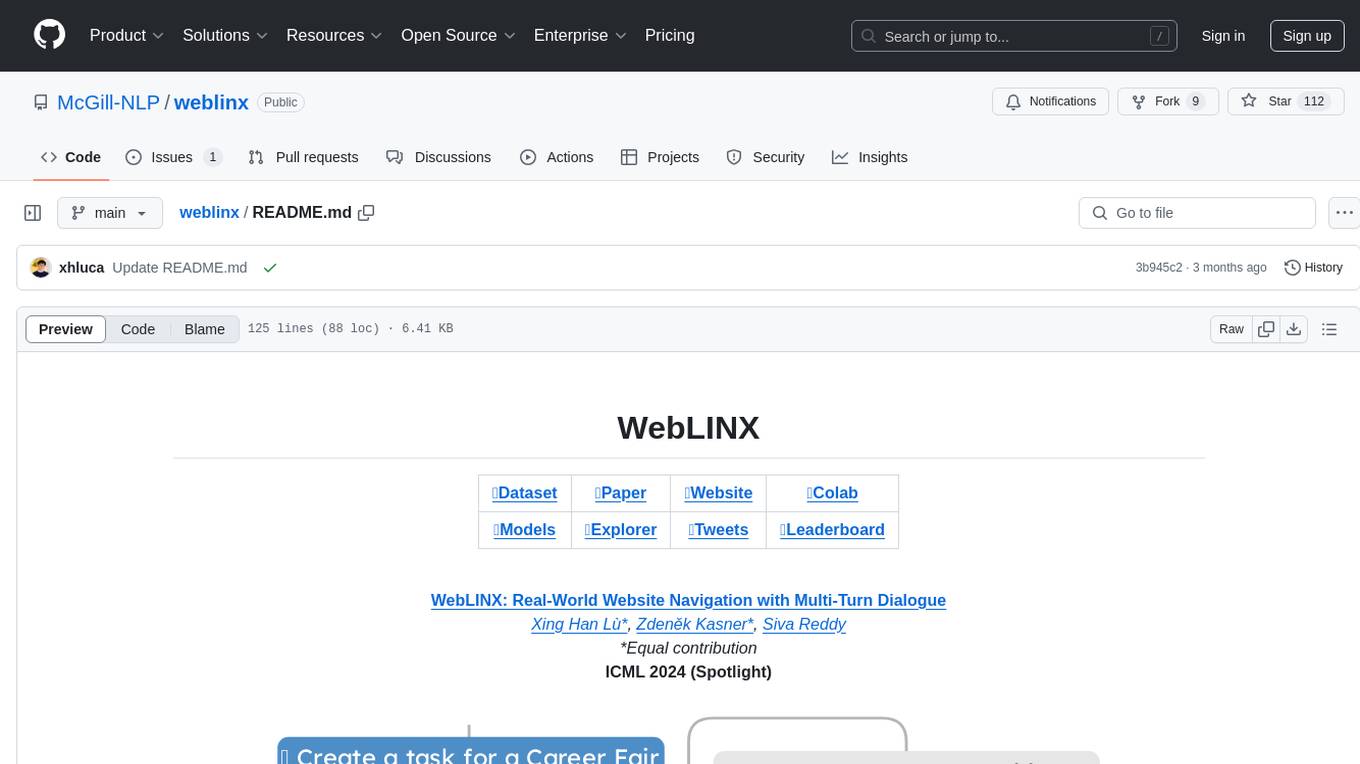
weblinx
WebLINX is a Python library and dataset for real-world website navigation with multi-turn dialogue. The repository provides code for training models reported in the WebLINX paper, along with a comprehensive API to work with the dataset. It includes modules for data processing, model evaluation, and utility functions. The modeling directory contains code for processing, training, and evaluating models such as DMR, LLaMA, MindAct, Pix2Act, and Flan-T5. Users can install specific dependencies for HTML processing, video processing, model evaluation, and library development. The evaluation module provides metrics and functions for evaluating models, with ongoing work to improve documentation and functionality.
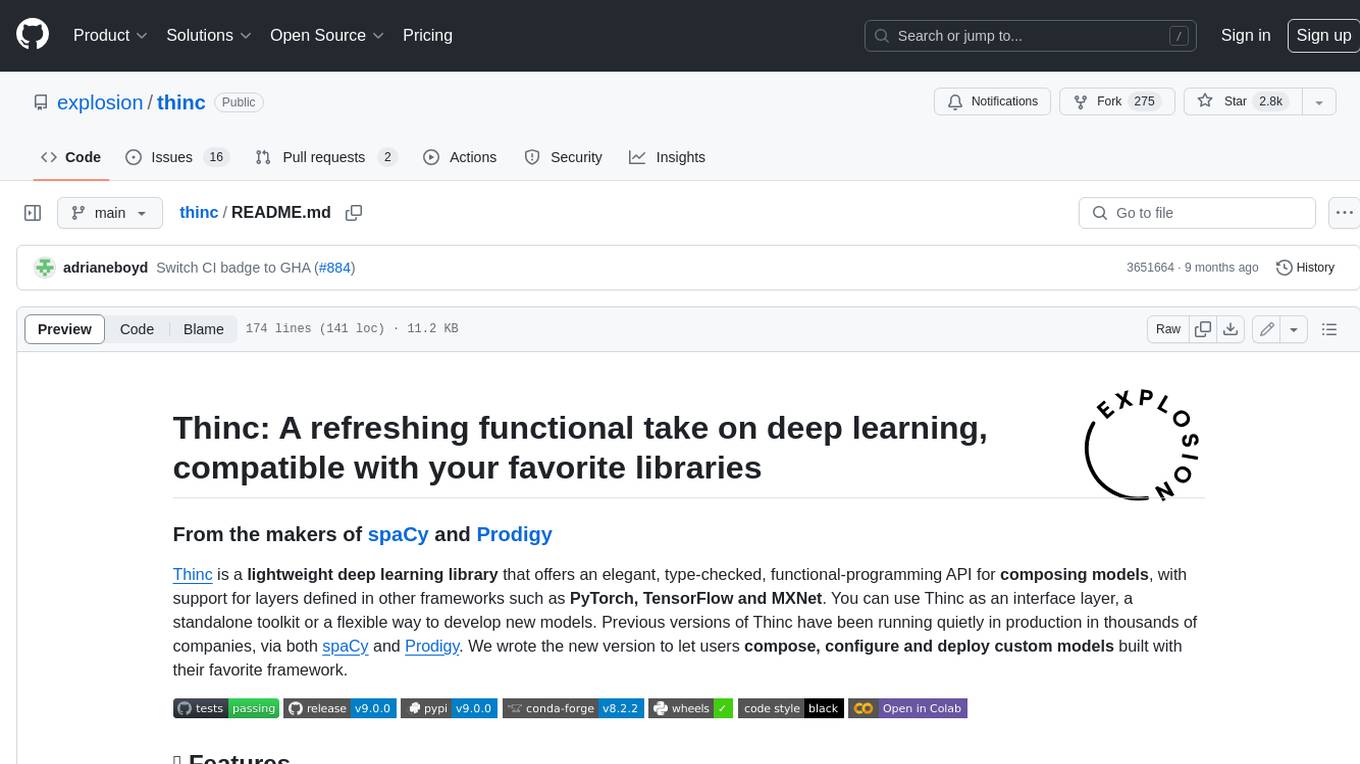
thinc
Thinc is a lightweight deep learning library that offers an elegant, type-checked, functional-programming API for composing models, with support for layers defined in other frameworks such as PyTorch, TensorFlow and MXNet. You can use Thinc as an interface layer, a standalone toolkit or a flexible way to develop new models.
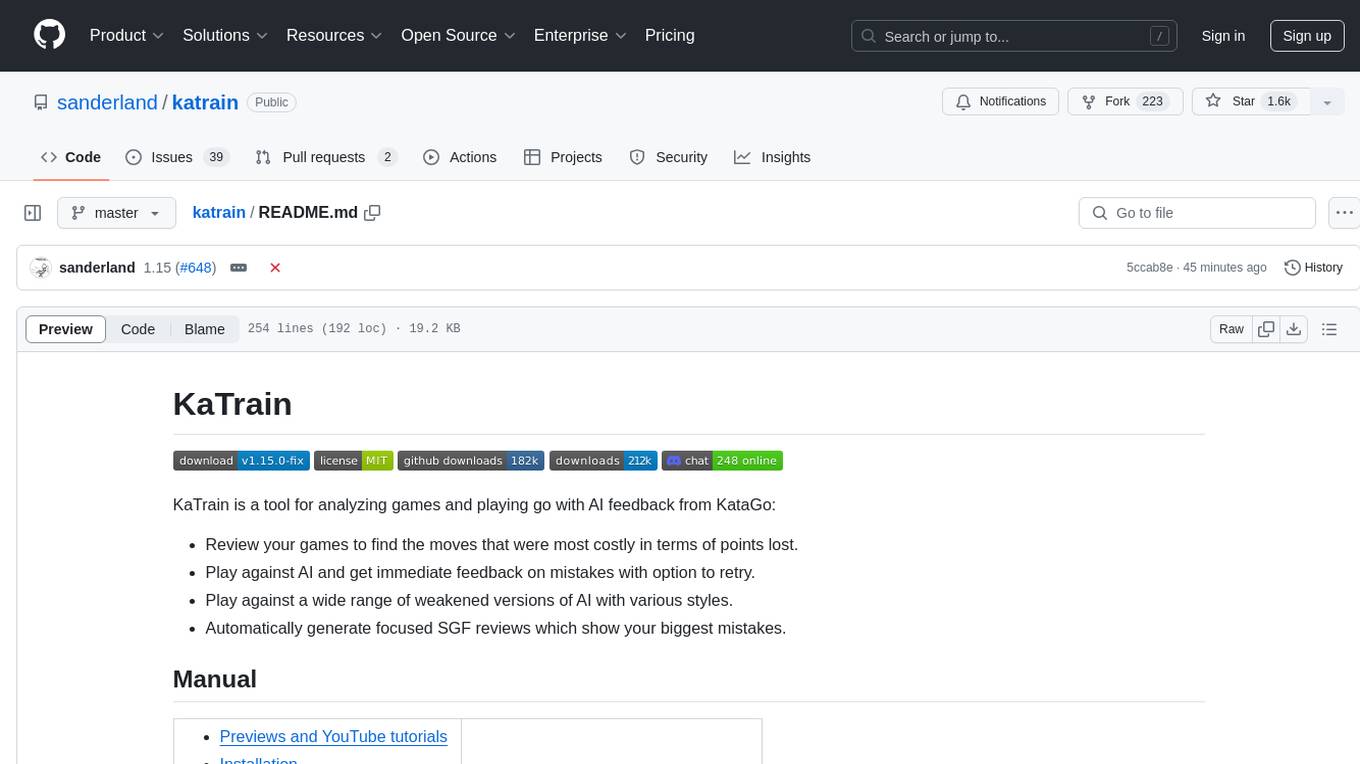
katrain
KaTrain is a tool designed for analyzing games and playing go with AI feedback from KataGo. Users can review their games to find costly moves, play against AI with immediate feedback, play against weakened AI versions, and generate focused SGF reviews. The tool provides various features such as previews, tutorials, installation instructions, and configuration options for KataGo. Users can play against AI, receive instant feedback on moves, explore variations, and request in-depth analysis. KaTrain also supports distributed training for contributing to KataGo's strength and training bigger models. The tool offers themes customization, FAQ section, and opportunities for support and contribution through GitHub issues and Discord community.
For similar tasks

llama-zip
llama-zip is a command-line utility for lossless text compression and decompression. It leverages a user-provided large language model (LLM) as the probabilistic model for an arithmetic coder, achieving high compression ratios for structured or natural language text. The tool is not limited by the LLM's maximum context length and can handle arbitrarily long input text. However, the speed of compression and decompression is limited by the LLM's inference speed.
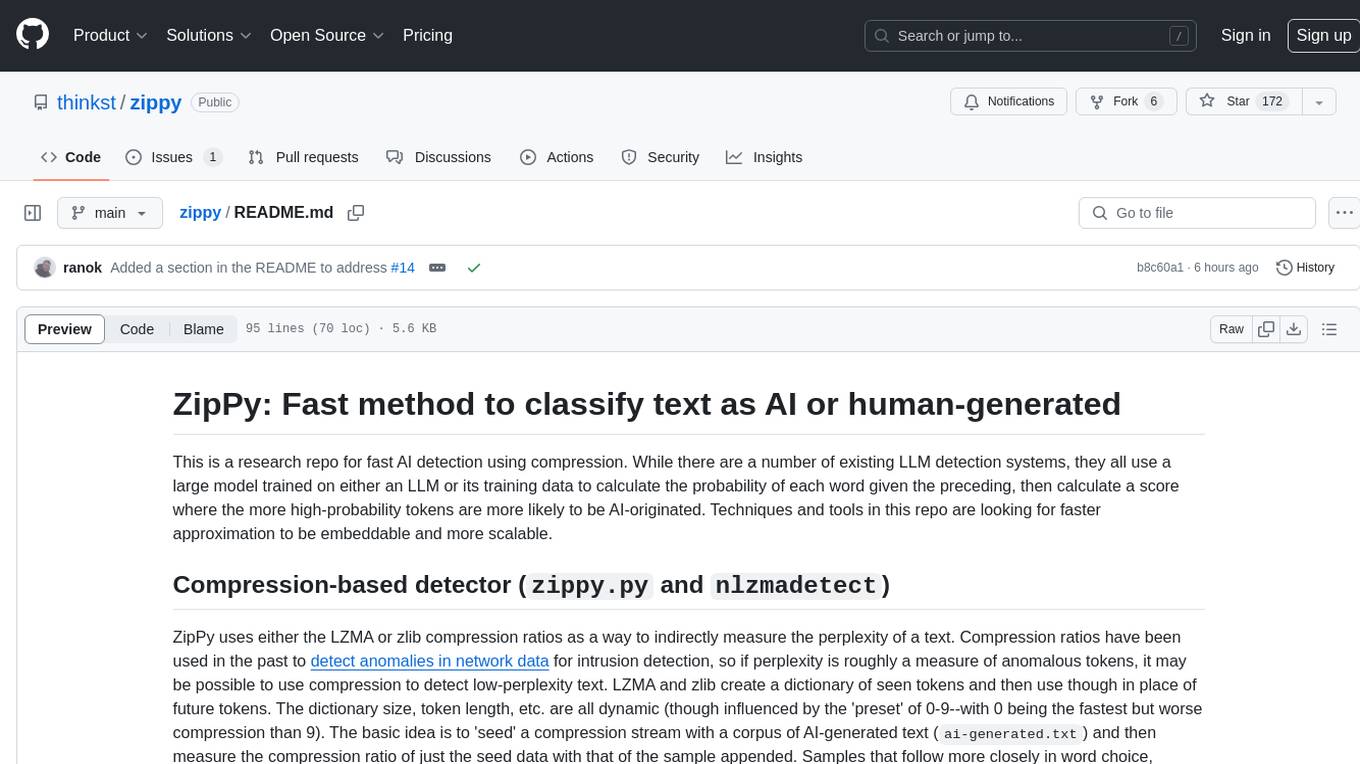
zippy
ZipPy is a research repository focused on fast AI detection using compression techniques. It aims to provide a faster approximation for AI detection that is embeddable and scalable. The tool uses LZMA and zlib compression ratios to indirectly measure the perplexity of a text, allowing for the detection of low-perplexity text. By seeding a compression stream with AI-generated text and comparing the compression ratio of the seed data with the sample appended, ZipPy can identify similarities in word choice and structure to classify text as AI or human-generated.
For similar jobs
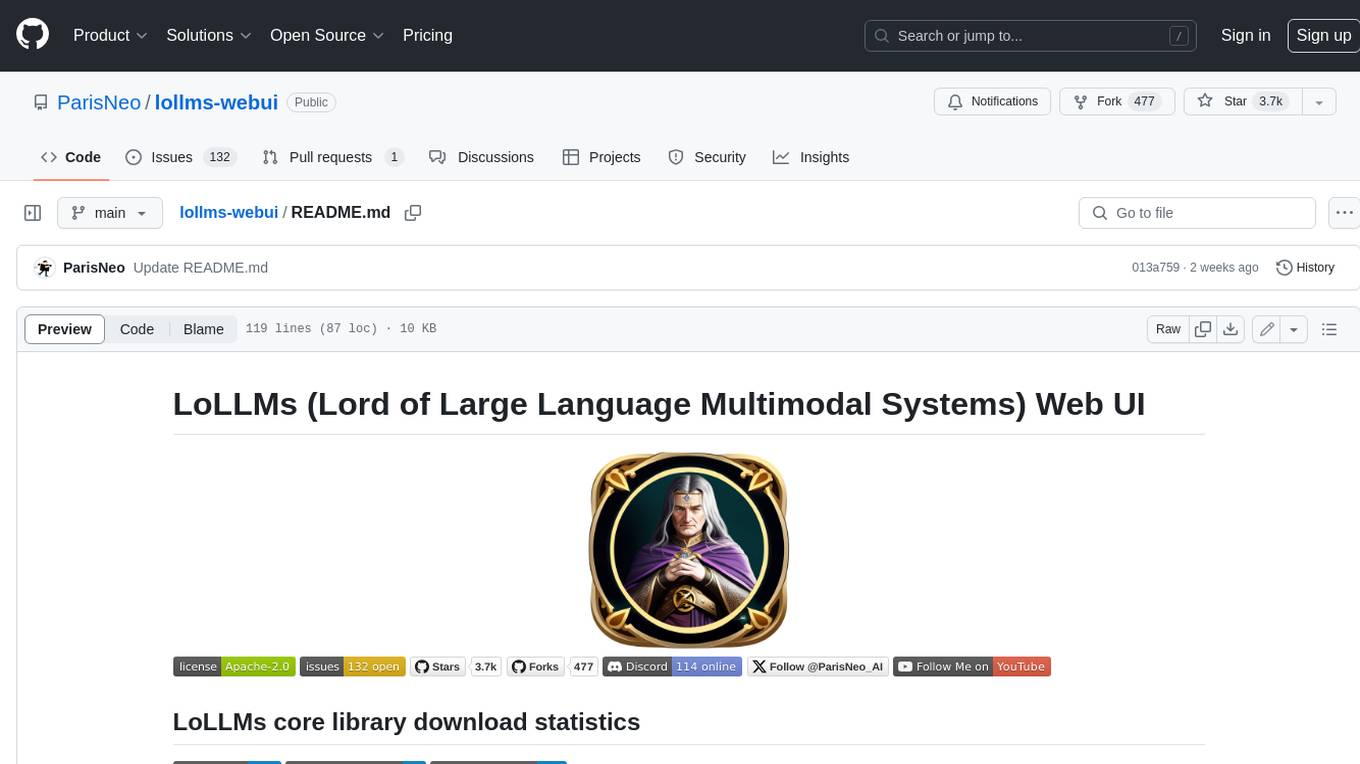
lollms-webui
LoLLMs WebUI (Lord of Large Language Multimodal Systems: One tool to rule them all) is a user-friendly interface to access and utilize various LLM (Large Language Models) and other AI models for a wide range of tasks. With over 500 AI expert conditionings across diverse domains and more than 2500 fine tuned models over multiple domains, LoLLMs WebUI provides an immediate resource for any problem, from car repair to coding assistance, legal matters, medical diagnosis, entertainment, and more. The easy-to-use UI with light and dark mode options, integration with GitHub repository, support for different personalities, and features like thumb up/down rating, copy, edit, and remove messages, local database storage, search, export, and delete multiple discussions, make LoLLMs WebUI a powerful and versatile tool.
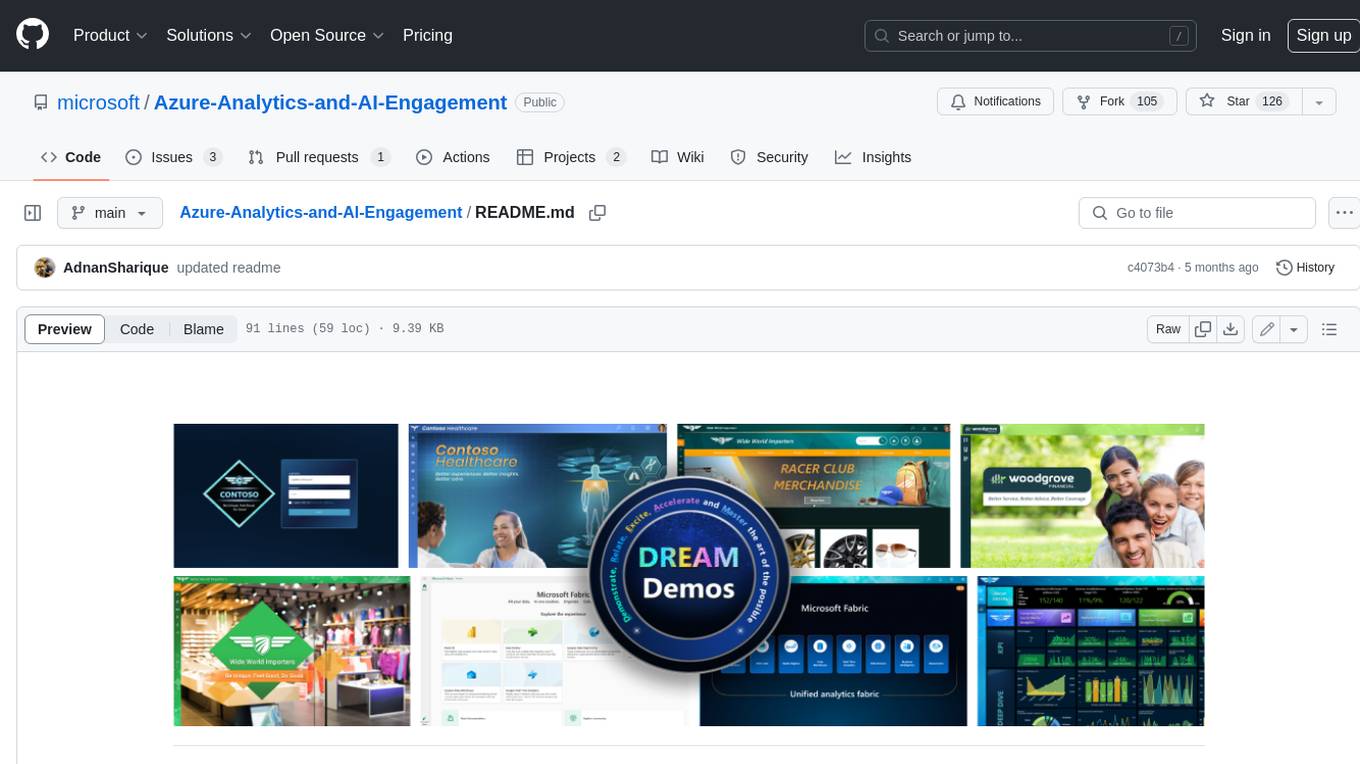
Azure-Analytics-and-AI-Engagement
The Azure-Analytics-and-AI-Engagement repository provides packaged Industry Scenario DREAM Demos with ARM templates (Containing a demo web application, Power BI reports, Synapse resources, AML Notebooks etc.) that can be deployed in a customer’s subscription using the CAPE tool within a matter of few hours. Partners can also deploy DREAM Demos in their own subscriptions using DPoC.
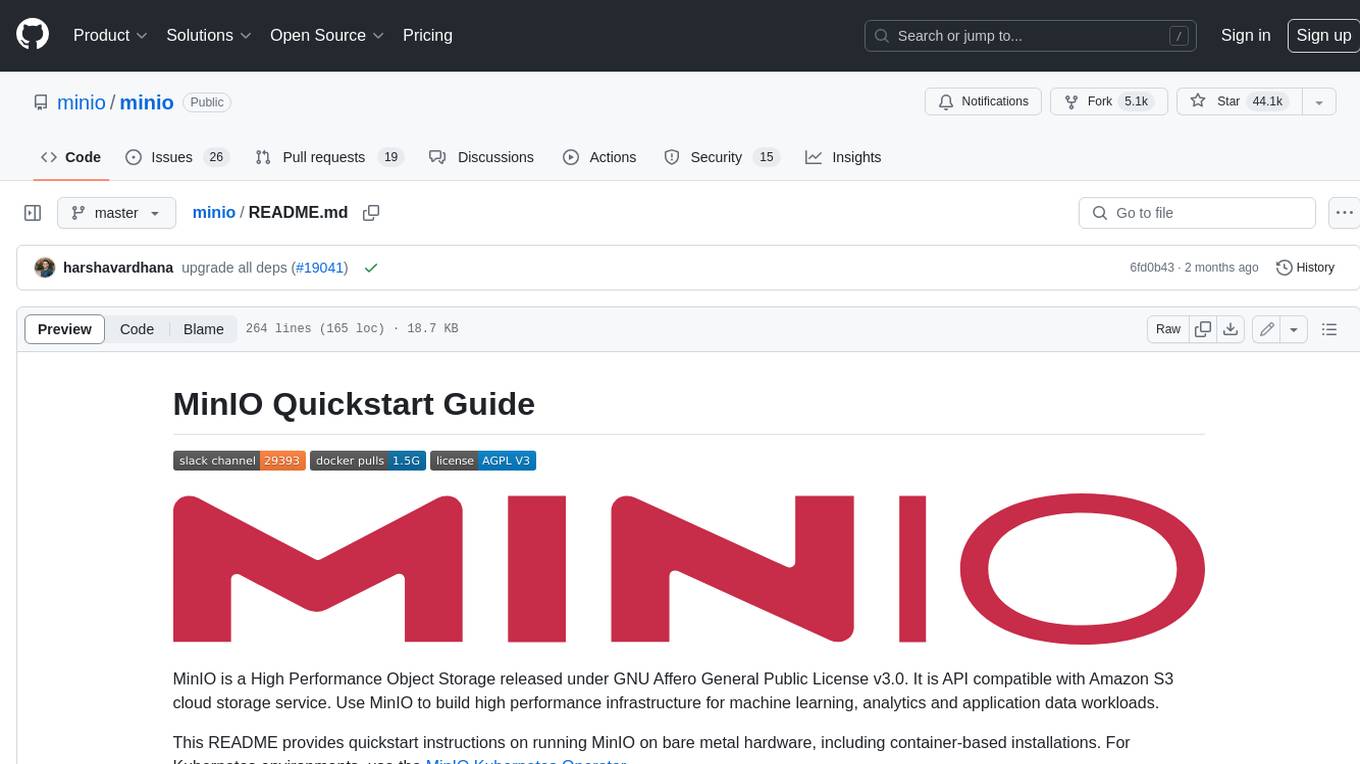
minio
MinIO is a High Performance Object Storage released under GNU Affero General Public License v3.0. It is API compatible with Amazon S3 cloud storage service. Use MinIO to build high performance infrastructure for machine learning, analytics and application data workloads.
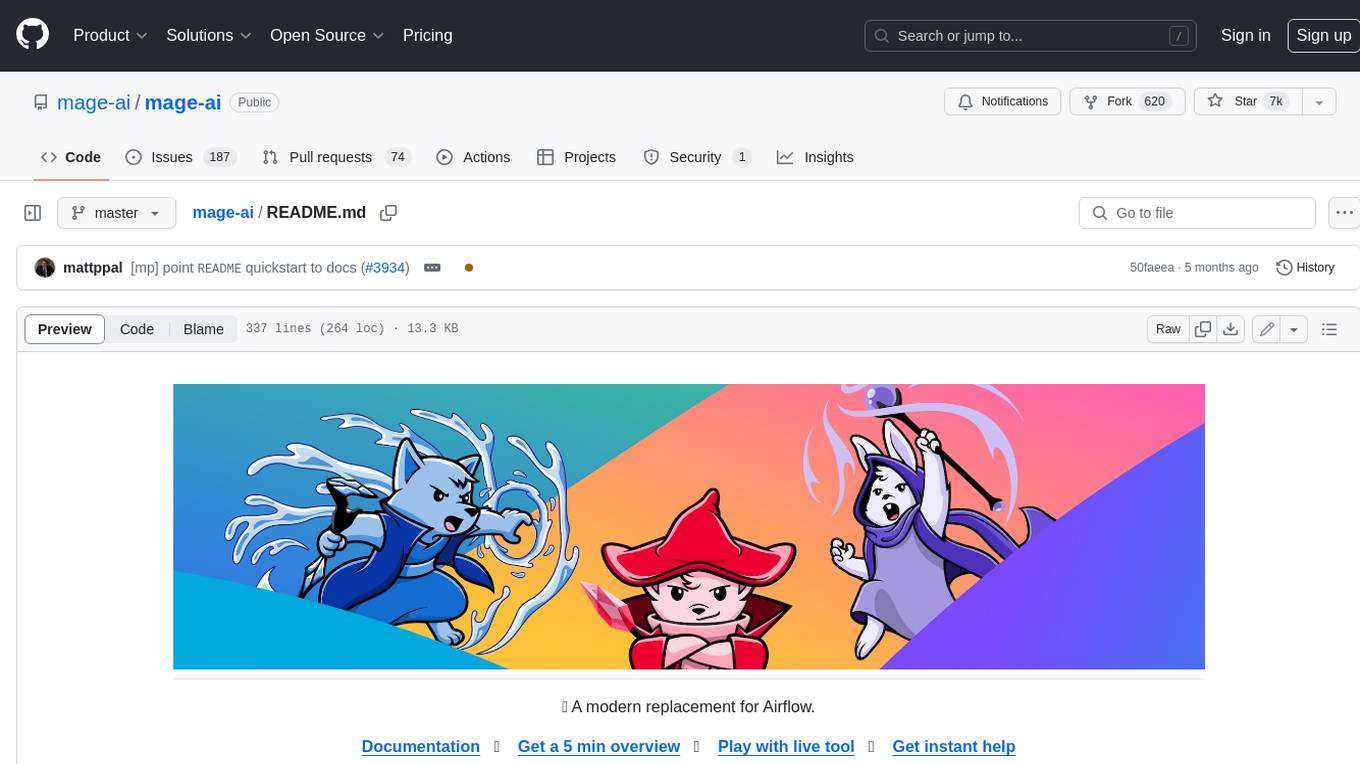
mage-ai
Mage is an open-source data pipeline tool for transforming and integrating data. It offers an easy developer experience, engineering best practices built-in, and data as a first-class citizen. Mage makes it easy to build, preview, and launch data pipelines, and provides observability and scaling capabilities. It supports data integrations, streaming pipelines, and dbt integration.
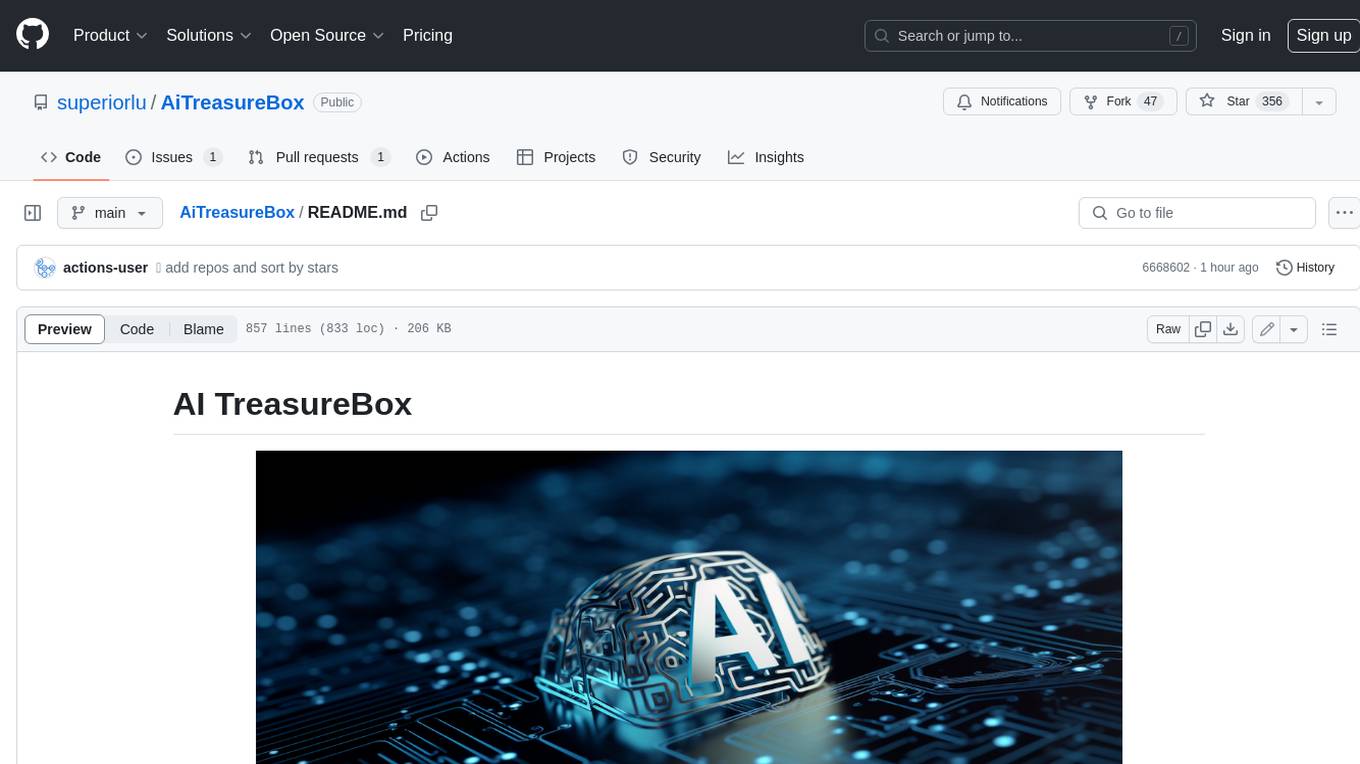
AiTreasureBox
AiTreasureBox is a versatile AI tool that provides a collection of pre-trained models and algorithms for various machine learning tasks. It simplifies the process of implementing AI solutions by offering ready-to-use components that can be easily integrated into projects. With AiTreasureBox, users can quickly prototype and deploy AI applications without the need for extensive knowledge in machine learning or deep learning. The tool covers a wide range of tasks such as image classification, text generation, sentiment analysis, object detection, and more. It is designed to be user-friendly and accessible to both beginners and experienced developers, making AI development more efficient and accessible to a wider audience.
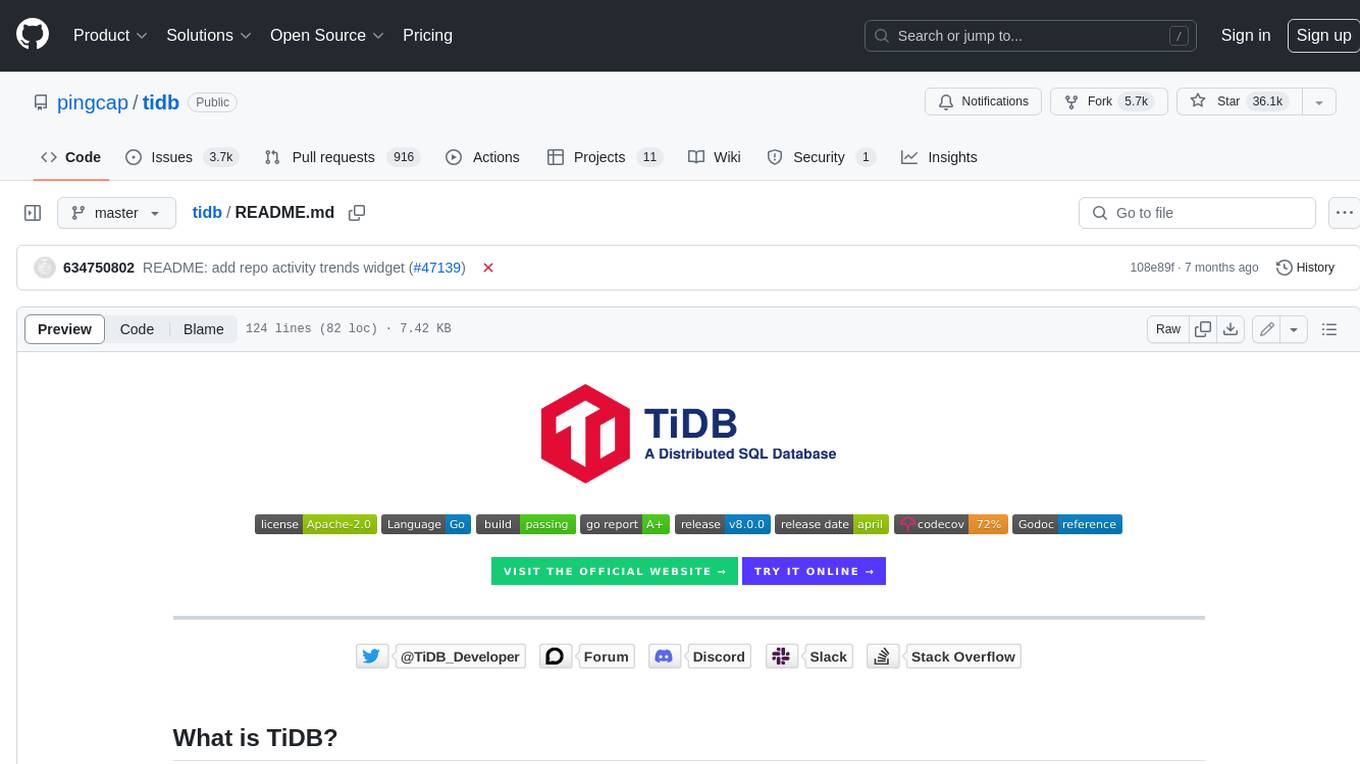
tidb
TiDB is an open-source distributed SQL database that supports Hybrid Transactional and Analytical Processing (HTAP) workloads. It is MySQL compatible and features horizontal scalability, strong consistency, and high availability.
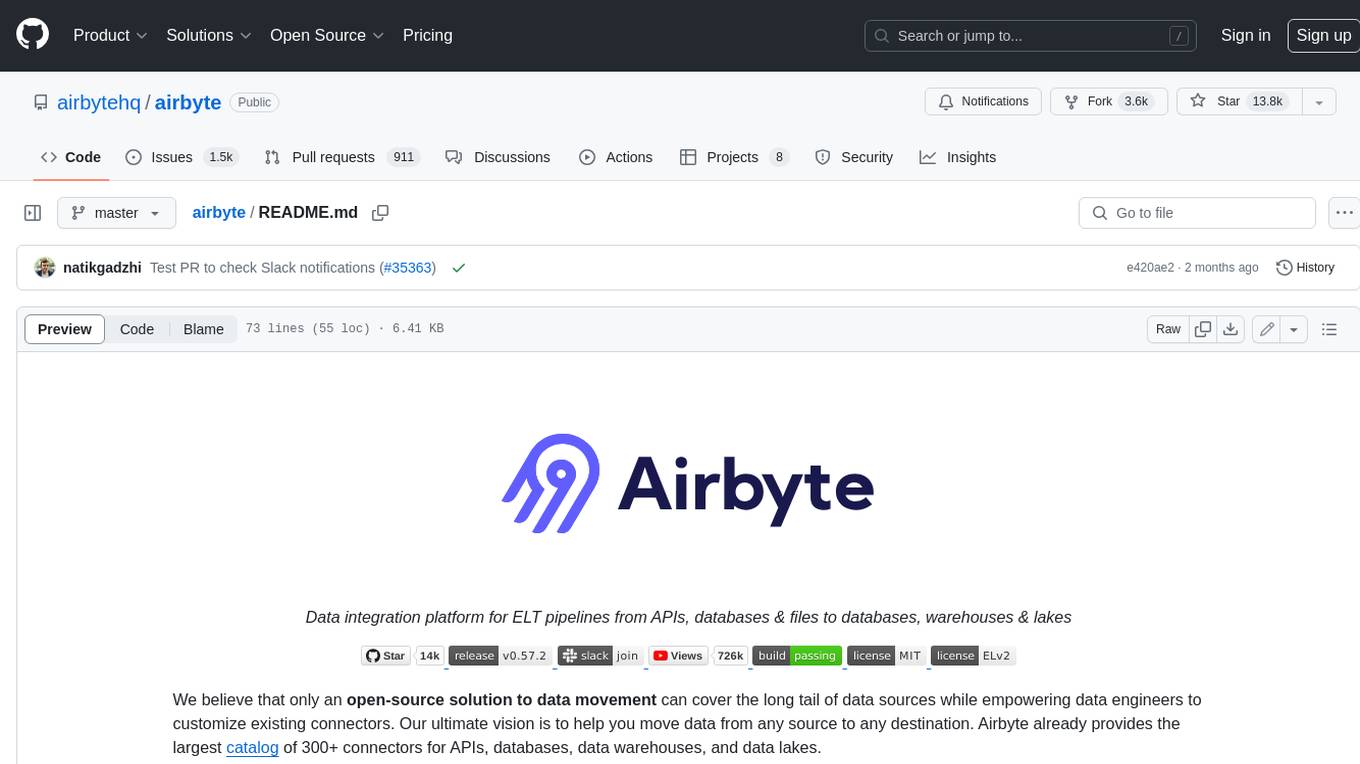
airbyte
Airbyte is an open-source data integration platform that makes it easy to move data from any source to any destination. With Airbyte, you can build and manage data pipelines without writing any code. Airbyte provides a library of pre-built connectors that make it easy to connect to popular data sources and destinations. You can also create your own connectors using Airbyte's no-code Connector Builder or low-code CDK. Airbyte is used by data engineers and analysts at companies of all sizes to build and manage their data pipelines.
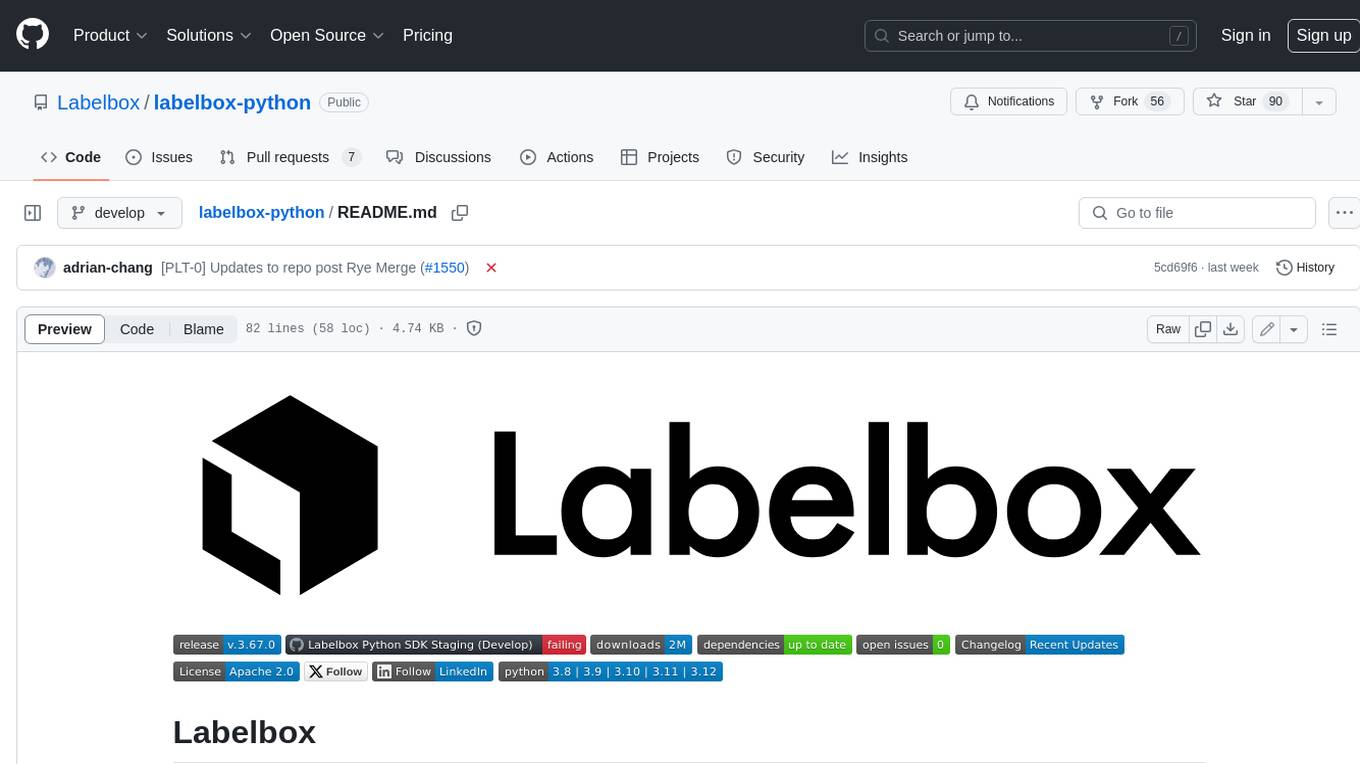
labelbox-python
Labelbox is a data-centric AI platform for enterprises to develop, optimize, and use AI to solve problems and power new products and services. Enterprises use Labelbox to curate data, generate high-quality human feedback data for computer vision and LLMs, evaluate model performance, and automate tasks by combining AI and human-centric workflows. The academic & research community uses Labelbox for cutting-edge AI research.
